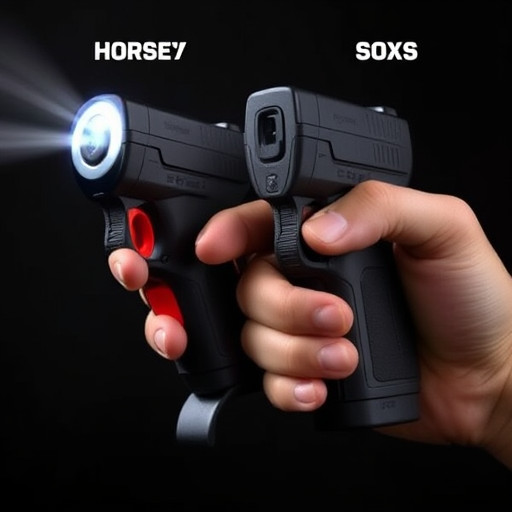This text compares stun guns and tasers, two non-lethal weapons designed for incapacitation. Key differences include operational principles: stun guns use high-voltage pulses from metal probes in direct contact, while tasers fire low-voltage electric charges via probe-like electrodes. Tasers are more versatile with broader voltage options and multiple firing modes; they require more skill to operate effectively. Stun guns deliver higher voltages for quicker sensory paralysis but pose greater injury risks. Their application methods differ: stun guns for disorientation at a distance, tasers for direct muscle disruption.
Understanding the distinction between stun guns and tasers is crucial for anyone interested in personal safety or law enforcement. While both devices utilize electric shock to disable assailants, they differ significantly in voltage, functionality, and application. This article breaks down the key differences between stun guns and tasers, focusing on their voltage levels, common uses, impact on targets, and safety considerations. By exploring these aspects, users can make informed decisions regarding self-defense tools, keeping in mind the legal implications and risks associated with high-voltage devices.
Understanding Stun Guns and Tasers
Stun guns and tasers are both non-lethal weapons designed to incapacitate individuals, but they operate on distinct principles. A stun gun delivers high-voltage electrical pulses through metal probes or contacts, causing intense pain, muscle spasms, and temporary paralysis. It depends on direct contact between the device and the target, making it less effective against individuals wearing protective gear or water.
In contrast, a taser uses two thin probes connected to electrodes that fire electric charges into the target, disrupting muscle control through overstimulation. Tasers can operate at various voltage levels and offer options for prong deployment. They are generally considered more versatile than stun guns, as they don’t require direct contact, can penetrate clothing, and provide a range of firing modes tailored to different situations. The difference between stun gun and taser voltage further highlights these distinctions, with tasers offering a broader spectrum of electrical energy delivery.
– Definition and basic function
Stun guns and tasers are both non-lethal weapons designed to incapacitate an opponent, but they operate on different principles and have distinct features. A stun gun delivers a high-voltage electrical shock through metal prongs or points that make contact with the target’s body. This sudden jolt of electricity disrupts muscle control, causing the person to temporarily lose balance and become immobilized. Stun guns are typically easy to use, often requiring just a simple press of a trigger to activate.
In contrast, a taser uses two probe-like electrodes that fire into the target at close range, delivering a series of low-voltage electrical pulses. These pulses interfere with the body’s neuromuscular system, resulting in powerful muscle contractions and loss of control. Tasers are known for their ability to disable multiple aggressors simultaneously due to their extended reach and the use of multiple probes. They require a bit more training and precision to operate effectively compared to stun guns. The difference between stun gun and taser voltage lies in their delivery method, with stun guns focusing on direct contact shocks and tasers utilizing projectile electrodes for broader impact.
– Common uses and applications
Stun guns and tasers are both non-lethal self-defense tools that use electric current to incapacitate individuals, but they operate with distinct mechanisms and have unique common uses. Stun guns emit a high-voltage, low-current electrical discharge, causing severe pain and muscle spasms in the targeted area. They are often used by law enforcement and civilians for personal protection against assailants. On the other hand, tasers (or stun guns with probes) use two thin, conductive probes connected to the device via insulated wires to deliver a controlled electric shock across the body of the target, temporarily disrupting motor functions. This makes them versatile tools for scenarios where immobilization is necessary, such as in law enforcement operations, personal security situations, and even in animal control.
The difference between stun guns and tasers lies in their application methods. Stun guns are typically fired at a range, aiming to strike the target’s face or body to cause disorientation and temporary incapacitation. In contrast, tasers require direct contact or proximity to the target, as the probes must make electrical connection for the shock to be effective. This distinction affects how and where these devices are employed in various situations, ensuring users can select the most suitable tool based on their specific needs and circumstances.
Voltage Comparison: Stun Gun vs Taser
When comparing stun guns and tasers, one of the most talked-about aspects is their voltage. Both devices deliver an electric shock to incapacitate a target, but they do so at different voltage levels. Stun guns typically operate within the range of 30,000 to 150,000 volts, while tasers usually use a lower voltage range, generally between 1,000 and 3,000 volts.
This difference in voltage directly impacts the devices’ effectiveness and safety. Tasers are designed to deliver a controlled electrical impulse that disrupts muscle control, causing the target to fall to the ground. The lower voltage makes tasers safer for use as they minimize the risk of serious injury or permanent damage. In contrast, stun guns produce a higher voltage surge intended to temporarily paralyze the senses and disrupt balance, allowing the user to escape or subdue their assailant.
